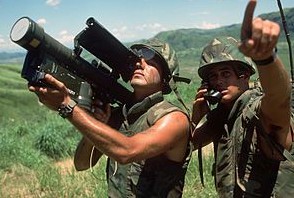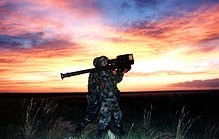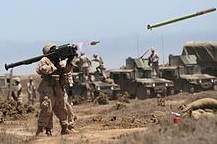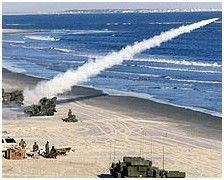
FIM-92 Stinger
USINFO | 2013-11-29 15:48
| Stinger | |
 A U.S. Marine with a field radio relays the direction of aircraft approaching to the operator of an FIM-92 Stinger missile launcher in September 1984. |
|
| Type | Man-portable surface-to-air missile |
| Place of origin | United States |
| Service history | |
| In service | 1981–present |
| Used by | See Operators |
| Wars | Falklands War, Soviet invasion of Afghanistan, Angolan Civil War, Kargil War, Yugoslav Wars, Invasion of Grenada |
| Production history | |
| Designer | General Dynamics |
| Designed | 1967 |
| Manufacturer | Raytheon Missile Systems |
| Unit cost | U.S.$38,000 |
| Produced | 1978 |
| Variants | FIM-92A, FIM-92B, FIM-92C, FIM-92D, FIM-92G |
| Specifications (FIM-92 Stinger) | |
| Weight | 33.5 lb , 15.19 kg |
| Length | 1.52 m () |
| Diameter | (2.76 in) |
| Crew | 1 |
|
|
|
| Effective range | 4.8 kilometres (3.0 mi) (FIM-92C Stinger-RMP Block II) |
| Warhead weight | () |
|
|
|
| Engine | Solid rocket motor |
|
Guidance system |
Infrared homing |
|
Launch platform |
MANPADS, M6 Linebacker,EurocopterTiger, AN/TWQ-1 Avenger, MQ-1 Predator, AH-64 Apache, T-129 ATAK |
The FIM-92 Stinger is a personal portable infrared homing surface-to-air missile (SAM), which can be adapted to fire from ground vehicles or helicopters (as an AAM), developed in the United States and entered into service in 1981. Used by the militaries of the United States and by 29 other countries, it is manufactured by Raytheon Missile Systems and under license by EADS in Germany, with 70,000 missiles produced. It is classified as a Man-Portable Air-Defense System (MANPADS).
Description
Light to carry and easy to operate, the FIM-92 Stinger is a passive surface-to-air missile, shoulder-fired by a single operator, although officially it requires two. The FIM-92B missile can also be fired from the M-1097 Avenger and M6 Linebacker. The missile is also capable of being deployed from a Humvee Stinger rack, and can be used by paratroopers. A helicopter launched version exists called Air-to-Air Stinger (ATAS).The missile is 1.52 m (5.0 ft) long and 70 mm (2.8 in) in diameter with 10 cm fins. The missile itself weighs 10.1 kg (22 lb), while the missile with launcher weighs approximately 15.2 kg (34 lb). The Stinger is launched by a small ejection motor that pushes it a safe distance from the operator before engaging the main two-stage solid-fuel sustainer, which accelerates it to a maximum speed of Mach 2.2 (750 m/s). The warhead is a 3 kg penetrating hit-to-kill warhead type with an impact fuze and a self-destruct timer.
To fire the missile, a BCU (Battery Coolant Unit) is inserted into the handguard. This shoots a stream of argon gas into the system, as well as a chemical energy charge that enables the acquisition indicators and missile to get power. The batteries are somewhat sensitive to abuse, with a limited amount of gas. Over time, and without proper maintenance, they can become unserviceable. The IFF system receives power from a rechargeable battery. Guidance to the target is initially through proportional navigation, then switches to another mode that directs the missile towards the target airframe instead of its exhaust plume.
The launcher tube can be reused and reloaded with more missiles.
There are three main variants in use: the Stinger basic, STINGER-Passive Optical Seeker Technique (POST), and STINGER-Reprogrammable Microprocessor (RMP).
The Stinger-RMP is so-called because of its ability to load a new set of software via ROM chip inserted in the grip at the depot. If this download to the missile fails during power-up, basic functionality runs off the on-board ROM. The four-processor RMP has 4 KB of RAM for each processor. Since the downloaded code runs from RAM, there is little space to spare, particularly for processors dedicated to seeker input processing and target analysis. The RMP has a dual-detector seeker: IR and UV. This allows it to distinguish targets from countermeasures much better than theRedeye, which was IR-only. While modern flares can have an IR signature that is closely matched to the launching aircraft's engine exhaust, there is a readily distinguishable difference in UV signature between flares and jet engines.
History

New Mexico Army National Guardsoldiers train with a Stinger missile launcher in 1999.

A U.S. Marine fires an FIM-92A Stinger missile during a July 2009 training exercise in California.
Initial work on the missile was begun by General Dynamics in 1967 as the Redeye II. It was accepted for further development by the U.S. Army in 1971 and designated FIM-92; the Stinger appellation was chosen in 1972. Because of technical difficulties that dogged testing, the first shoulder launch was not until mid-1975. Production of the FIM-92A began in 1978 to replace the FIM-43 Redeye. An improved Stinger with a new seeker, the FIM-92B, was produced from 1983 alongside the FIM-92A. Production of both the A and B types ended in 1987 with around 16,000 missiles produced.The replacement FIM-92C had been developed from 1984 and production began in 1987. The first examples were delivered to front-line units in 1989. C-type missiles were fitted with a reprogrammable electronics system to allow for upgrades. The missiles which received a counter-measures upgrade were designated D and later upgrades to the D were designated G.
The FIM-92E or Block I was developed from 1992 and delivered from 1995 (certain sources state that the FIM-92D is also part of the Block I development). The main changes were again in the sensor and the software, improving the missile's performance against smaller and low-signature targets. A software upgrade in 2001 was designated F. Block II development began in 1996 using a new focal plane array sensor to improve the missile's effectiveness in "high clutter" environments and increase the engagement range to about 25,000 feet (7,600 m). Production was scheduled for 2004, but Jane's reports that this may be on hold. Japanese Self-Defense Forces have the also derived type. Since 1984 the Stinger has been issued to many U.S. Navy warships for point defense, particularly inMiddle Eastern waters, with a three-man team that can perform other duties when not conducting Stinger training or maintenance. Until it was decommissioned in September 1993, the U.S. Navy had at least one Stinger Gunnery Detachment attached to Beachmaster Unit Two in Little Creek Virginia. The sailors of this detachment would deploy to carrier battlegroups in teams of two to four sailors per ship as requested by Battle Group Commanders.
Comparison chart to other MANPADS
| 9K34 Strela-3 /SA-14 | 9K38 Igla /SA-18 | 9K310 Igla-1 /SA-16 | 9K338 Igla-S /SA-24 | FIM-92C Stinger | |
| Service entry | 1974 | 1983 | 1981 | 2004 | 1987 |
|
Weight, full system, ready to shoot |
16.0 kg (35.3 lb) | 17.9 kg (39 lb) | 17.9 kg (39 lb) | 19 kg (42 lb) | 14.3 kg (32 lb) |
| Weight, missile | 10.3 kg (23 lb) | 10.8 kg (24 lb) | 10.8 kg (24 lb) | 11.7 kg (26 lb) | 10.1 kg (22 lb) |
| Weight, warhead |
1.17 kg (2.6 lb), 390 g (14 oz) HMX |
1.17 kg (2.6 lb), 390 g (14 oz) HMX |
1.17 kg (2.6 lb), 390 g (14 oz) HMX |
2.5 kg (5.5 lb), 585 g (20.6 oz) HMX |
3 kg (6.6 lb) HE |
| Warhead type |
Directed-energy blast fragmentation |
Directed-energy blast fragmentation |
Directed-energy blast fragmentation |
Directed-energy blast fragmentation |
Annular blast fragmentation |
| Fuze type | Impact and grazing fuze. |
Delayed impact, magnetic and grazing. |
Delayed impact, magnetic and grazing. |
Delayed impact, magnetic and grazing. |
Delayed impact. |
| Flight speed, average / peak | 470 m/s (1,100 mph) sustained |
600 m/s (1,300 mph) / 800 m/s (1,800 mph) |
570 m/s (1,300 mph) sustained (in + temperature) |
? |
700 m/s (1,600 mph) / 750 m/s (1,700 mph) |
| Maximum range | 4,100 m (13,500 ft) | 5,200 m (17,100 ft) | 5,000 m (16,000 ft) | 6,000 m (20,000 ft) | 4,500 m (14,800 ft) |
| Maximum target speed, receding | 260 m/s (580 mph) | 360 m/s (810 mph) | 360 m/s (810 mph) | 400 m/s (890 mph) | ? |
| Maximum target speed, approaching | 310 m/s (690 mph) | 320 m/s (720 mph) | 320 m/s (720 mph) | 320 m/s (720 mph) | ? |
| Seeker head type |
Nitrogen-cooled, lead sulfide (PbS) |
Nitrogen-cooled, Indium antimonide (InSb) and uncooled lead sulfide (PbS) |
Nitrogen-cooled, Indium antimonide (InSb) |
? |
Argon-cooled, Indium antimonide (InSb) |
| Seeker scanning | FM-modulated | FM-modulated | FM-modulated | FM-modulated | FM-modulated |
| Seeker notes |
Aerospike to reduce supersonic wave drag |
Tripod-mounted nosecone to reduce supersonic wave drag |
Service

U.S. Army soldiers from the 11th Air Defense Artillery Brigade stand next to a FIM-92A Stinger portable missile launcher during the Persian Gulf War.

A Stinger missile being launched from a U.S. Marine Corps AN/TWQ-1 Avenger in April 2000.
Falklands War
The Stinger's combat debut occurred during the Falklands War fought between Britain and Argentina. At the onset of the conflict soldiers of the BritishSpecial Air Service had been clandestinely equipped with six missiles, although they had received little instruction in their use. The sole SAS trooper who had received training on the system, and was due to train other troops, was killed in a helicopter crash on 19 May. Nonetheless, on 21 May 1982 an SAS soldier engaged and shot down an Argentine Pucará ground attack aircraft with a Stinger. On 30 May, at about 11.00 a.m., an Aerospatiale SA-330 Pumahelicopter was brought down by another missile, also fired by the SAS, in the vicinity of Mount Kent. Six National Gendarmerie Special Forces were killed and eight more wounded. The main MANPADS used by both sides during the Falklands War was the Blowpipe missile.Soviet War in Afghanistan
See also: List of Soviet aircraft losses in Afghanistan
The story of Stingers in Afghanistan is told in primarily by the western sources, notably in the references written in Charlie Wilson's War by George Crile, and Ghost Wars by Steve Coll.
In late 1985, several groups, such as Free the Eagle, began arguing the CIA was not doing enough to support the Mujahideen in the Russian-Afghan war. Michael Pillsbury, Vincent Cannistraro, and others put enormous bureaucratic pressure on the CIA to begin providing the Stinger to the rebels. The idea was controversial because up to that point, the CIA had been operating with the pretense that the United States was not involved in the war directly, for various reasons. All weapons supplied at that point were non-U.S. made weapons, like Type 56 rifles purchased from China, and AK-47 and AKM AK derivatives purchased from Egypt.
The final say-so came down to President General Muhammad Zia-ul-Haq through whom the CIA had to pass all of its funding and weapons to the Mujahideen. President Zia constantly had to gauge how much he could "make the pot boil" in Afghanistan without provoking a Soviet invasion of his own country. According to George Crile III, U.S. congressman Charlie Wilson's relationship with Zia was instrumental in the final go-ahead for the Stinger introduction.
Wilson and his associates at first viewed the Stinger as "just adding another component to the lethal mix we we're building". Their increasingly successful Afghanistan strategy, formed largely by Michael G. Vickers, was based on a broad mix of weapons, tactics, and logistics, not a 'silver bullet solution' of a single weapon. Furthermore the previous attempts to provide MANPADs to the Mujahideen, namely the SA7 and Blowpipe, hadn't worked very well.
Engineer Ghaffar of GulbuddinHekmatyar's Hezb-i-Islami, brought down the first Hind gunship with a Stinger on September 25, 1986 near Jalalabad. TheCentral Intelligence Agency eventually supplied nearly 500 Stingers (some sources claim 1,500–2,000) to the Mujahideen in Afghanistan as part of Operation Cyclone. with the supply of 250 launchers.
The impact of the stinger on the outcome of the war is contested. It should be noted that Soviet, and later, Russian, accounts give little significance to the stinger.
According to Crile, who includes information from Alexander Prokhanov, the Stinger was a "turning point". Milt Bearden saw it as a "force multiplier" and morale booster.[6] Charlie Wilson, the congressman behind the United States' Operation Cyclone, described the first Stinger Mi-24 shootdowns in 1986 as one of the three crucial moments of his experience in the war, saying "we never really won a set piece battle before September 26, and then we never lost one afterwards". He was given the first spent Stinger tube as a gift and kept it on his office wall.
The last Stingers were supplied in 1988 and after the 1989 Soviet withdrawal from Afghanistan, the U.S. attempted to buy back the Stinger missiles, with a $55 million program launched in 1990 to buy back around 300 missiles (US$183,300 each). The U.S. government collected most of the Stingers it had delivered, but by 1996 around 600 were unaccounted for and some found their way into Croatia, Iran, Sri Lanka, Qatar and North Korea. According to the CIA, already in August 1988 the U.S. had demanded from Qatar the return of Stinger missiles. Wilson later told CBS he "lived in terror" that a civilian airliner would be shot down by a Stinger, but he did not have misgivings about having provided Stingers to defeat the Soviets.
Angolan Civil War
The Reagan administration provided 310 Stingers to Jonas Savimbi's UNITA movement in Angola between 1986 and 1989. As in Afghanistan, efforts to recover missiles after the end of hostilities proved incomplete. The battery of a Stinger lasts for four or five years, so any weapons supplied in the 1980s would now be inoperative.
Libyan invasion of Chad
The Chadian government received Stinger missiles from the United States, when Libya invaded the northern part of the African country. On 8 October 1987, a Libyan Su-22MK was shot down by a FIM-92A fired by Chadian forces. The pilot, Capt. Diya al-Din, ejected and was captured. He was later granted political asylum by the French government. During the recovery operation, a Libyan MiG-23MS was shot down by a FIM-92A.[23]
Chechen War
Russian officials claimed several times the presence of US-made Stinger missiles in the hands of the Chechen militia and insurgents. They attributed few of their aerial losses to the American MANPADS. The presence of such missiles was confirmed by photo evidence even if it is not clear their actual number nor their origin.[24]
Sri Lankan Civil War
The Liberation Tigers of Tamil Eelam also managed to acquire one or several Stingers, possibly from former Mujahideen stocks, and used at least one to down a Sri Lanka Air Force Mi-24 on November 10, 1997.
Operation Enduring Freedom
See also: List of aviation accidents and incidents in the War in Afghanistan
Some of the Stingers that the U.S. supplied starting from 1987, could have been used during the U.S. intervention in Afghanistan. Due to political reasons, U.S. and coalition forces generally downplay or even deny any MANPADS involvement in the Afghan War by Afghan insurgents, attributing the attacks to unguided RPGs. However it became clear that coalition aircraft came under attack by different types of MANPADS in different instances.
United States
The current U.S. inventory contains 13,400 missiles. The total cost of the program is $7,281,000,000. It is rumored that the United States Secret Service has Stinger missiles to defend the President, a notion that has never been dispelled; however, U.S. Secret Service plans favor moving the President to a safer place in the event of an attack rather than shooting down the plane, lest the missile (or the wreckage of the target aircraft) hit innocents.
During the 1980s, the Stinger was used to support different US-aligned guerrilla forces, notably the Afghan Mujahidins, the Chad government against the Libyan invasion and the Angolan UNITA. The Nicaraguan contras were not provided with Stingers due to the lack of fixed wing aircraft of the Sandinista government, as such the previous generation FIM-43 Redeye was considered adequate.
Share this page



















